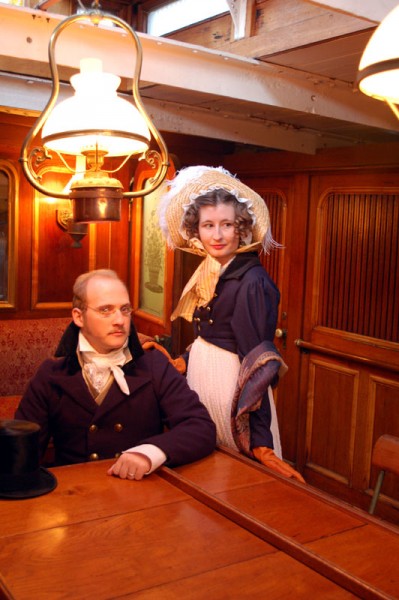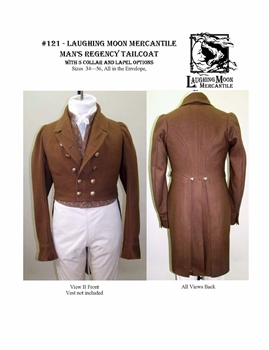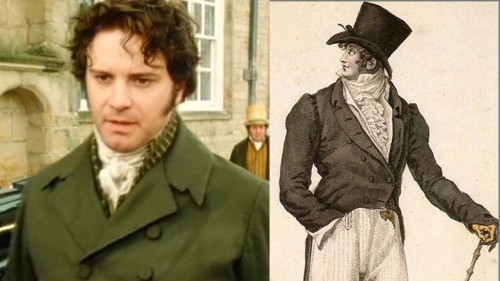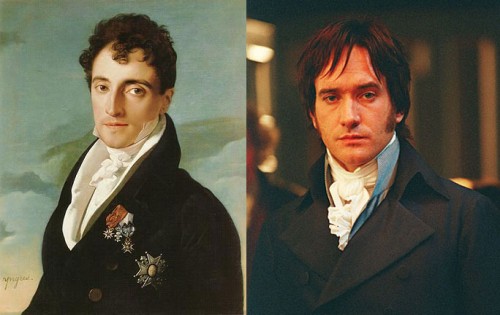I’m back from Costume College (photos to follow soon) and I’m really excited about my new sewing project. I have decided to make my husband a new Regency era tailcoat.
Pictured below is the previous tailcoat. You can read all blog entries on that here.

At Costume College last year I bought the Laughing Moon Men’s Regency Tailcoat pattern #121. The coat is a little late Regency, but I love that she said she took it from an original period garment.
 I made the mock up tonight and we tried it on. My husband has more squared shoulders than the original and we had some other alterations to make, but the thing we noticed after the initial fit concerns was the strange roll line. The roll line really popped up, and stood away from the neck. It’s so against modern “classic” tailoring rules, and I started to make a new neckline, but my friend Ginger pulled out some books and we started seeing that my engrained view of collar roll lines was incorrect in this period.
I made the mock up tonight and we tried it on. My husband has more squared shoulders than the original and we had some other alterations to make, but the thing we noticed after the initial fit concerns was the strange roll line. The roll line really popped up, and stood away from the neck. It’s so against modern “classic” tailoring rules, and I started to make a new neckline, but my friend Ginger pulled out some books and we started seeing that my engrained view of collar roll lines was incorrect in this period.
For example:

Look how far Mr Brummel’s coat stands away from his neck, and how high it pops up at the roll line.
And looking at period paintings and fashion plates, and comparing them with modern period movies, we see the same. The modern movies make the roll line where we’re accustomed to seeing it, while the original period sources make the collar stand up and out from the neck.


So, while this post doesn’t show any actual progress, I thought I’d share this little revelation. It makes my mind kind of turn inside out and I’m really trying not to look at it from our modern comprehension of fit, but the period one. I have to keep batting my hands down from drawing or pinning alterations, because the way it is in the Laughing Moon pattern is actually the way the collar is supposed to fit in the period.
So, for those of you who are also interested in Regency era menswear, I thought this might be useful information for you on fit.
Have you made any Regency era menswear? If so, share your info with me.

Dea
August 11, 2014 at 6:56 am (11 years ago)I find menswear in general to be a big mystifying experience. Having just made a vest and pants for my partner (we went to a wedding last weekend), I have decided menswear is just crazy. :-P I’m FINALLY at a place where I can make pants that will fit him, he likes the fit, and they hang nicely. This vest? Devil spawn. Also — the fabric leaked dye like it was it’s job. I had to clean my machine and iron afterwards!
How are the instructions on the LM pattern? I’ve never bought their stuff.
Laura
August 11, 2014 at 11:24 pm (11 years ago)I’m very interested to see how you get on, I’m planning on getting the same pattern to make a tailcoat for a friend and I’d love to see it made up first! Thanks for the notes on the collar, I haven’t done much tailored men’s wear so every observation is helpful!
Melissa A.
August 13, 2014 at 6:52 pm (11 years ago)I’m currently working on her pattern that is suited for earlier years because it doesn’t have a waist seam (I am going for the late teens in Regency fashions). What I found is that the collar roll line is right, the neck should be that high in the back, however the collar is extremely wide! The proportions are very far off from period examples that I’ve seen for the teens. Leave the collar stand where they put it, but don’t shy away from altering the size of the collar. I cut 1/2 inch to 2 inches off in certain places.
Renate
September 10, 2014 at 2:54 am (11 years ago)I have always felt so intimidated by the tailcoat, but recently I decided to just go ahead and make the attempt! I am planning to purchase the other regency pattern as well, minus the waist seam, and this is very useful info indeed! It’s so interesting to note how modern productions alter things to appeal more to a modern audience :)